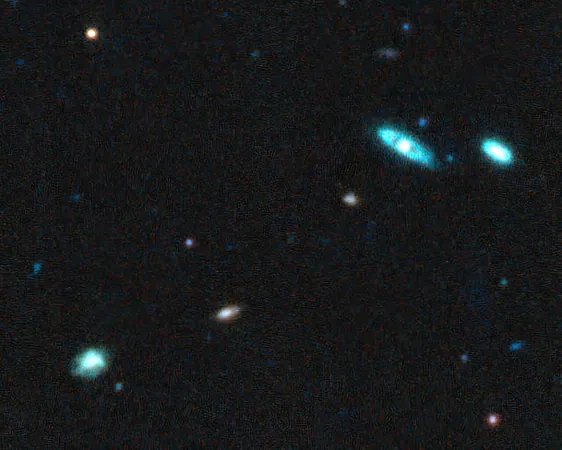
Unlocking the Secrets of the Universe: Major Discoveries from 'Cosmic Noon'
2025-04-22
Author: Sarah
A Breakthrough in Astronomy
Astrophysicists at the University of Kansas are leading an exhilarating journey into the universe’s past with a groundbreaking study using the James Webb Space Telescope. Their focus? The enigmatic epoch known as "cosmic noon," a time 2-3 billion years post-Big Bang when galaxies like our Milky Way experienced explosive growth.
Unveiling Stellar Birth During Cosmic Noon
According to researchers, this cosmic era was a crucible of star formation, with galaxies crafting about half their current stellar masses during this intense period. The research, which is set to be published in The Astrophysical Journal, shines a light on how these ancient starburst events laid the groundwork for galaxies today.
Join the Cosmic Collisions Project!
The KU team isn’t keeping all the action to themselves. They are calling on the public to aid in classifying galaxy shapes and spotting mergers through their engaging Cosmic Collisions Zooniverse project. "We aim to conduct the largest mid-infrared survey using JWST across multiple bandwidths," stated principal investigator Allison Kirkpatrick. "The mid-infrared unveils dust-obscured galaxies, letting us peek behind the cosmic curtain."
Exploring a Cosmic Landscape
With enhanced abilities in the mid-infrared spectrum, the KU researchers ventured to observe galaxies from 10 billion years ago, specifically those with active galactic nuclei—the supermassive black holes that are burgeoning in size. They focused on a galaxy-rich field near the Ursa Major constellation, a favored site for such celestial observation.
A Closer Look at the Extended Groth Strip
Known as the Extended Groth Strip, this area has become a key JWST observation field. Kirkpatrick highlighted, "I was involved in the very first proposal that acquired data from JWST, and this survey—the CEERS (Cosmic Evolution Early Release Science)—allowed us to glimpse about 10,000 galaxies in a patch of sky no bigger than the moon's diameter."
The Art of Data Processing
Lead author Bren Backhaus, a postdoctoral researcher, meticulously transformed raw JWST data into scientific images essential for the astronomy community. "Each image captures distinct wavelengths, akin to taking photos with varied color filters," Backhaus explained. She faced challenges like image misalignment and known imperfections in the telescope's output, skillfully correcting these to generate usable data.
Exclusive Access to Cosmic Data
So far, the KU-led collaboration has logged an impressive 67 hours commanding the JWST, with an additional 30 hours recently secured. "Our students have exclusive access to this invaluable dataset for now," Kirkpatrick noted. After one year, this data will become publicly available, but in its raw form, requiring further processing by interested researchers.
Research on the Milky Way's Ancestors
The ongoing research aims to identify ancient galaxies that could be the predecessors of today's Milky Way, exploring how these galaxies evolved and morphed through mergers over time. Kirkpatrick emphasized the significance of this work: "All my students are actively engaged in this. It’s a rare opportunity for KU, showcasing our commitment to unveiling the universe's mysteries!"
 Brasil (PT)
Brasil (PT)
 Canada (EN)
Canada (EN)
 Chile (ES)
Chile (ES)
 Česko (CS)
Česko (CS)
 대한민국 (KO)
대한민국 (KO)
 España (ES)
España (ES)
 France (FR)
France (FR)
 Hong Kong (EN)
Hong Kong (EN)
 Italia (IT)
Italia (IT)
 日本 (JA)
日本 (JA)
 Magyarország (HU)
Magyarország (HU)
 Norge (NO)
Norge (NO)
 Polska (PL)
Polska (PL)
 Schweiz (DE)
Schweiz (DE)
 Singapore (EN)
Singapore (EN)
 Sverige (SV)
Sverige (SV)
 Suomi (FI)
Suomi (FI)
 Türkiye (TR)
Türkiye (TR)
 الإمارات العربية المتحدة (AR)
الإمارات العربية المتحدة (AR)